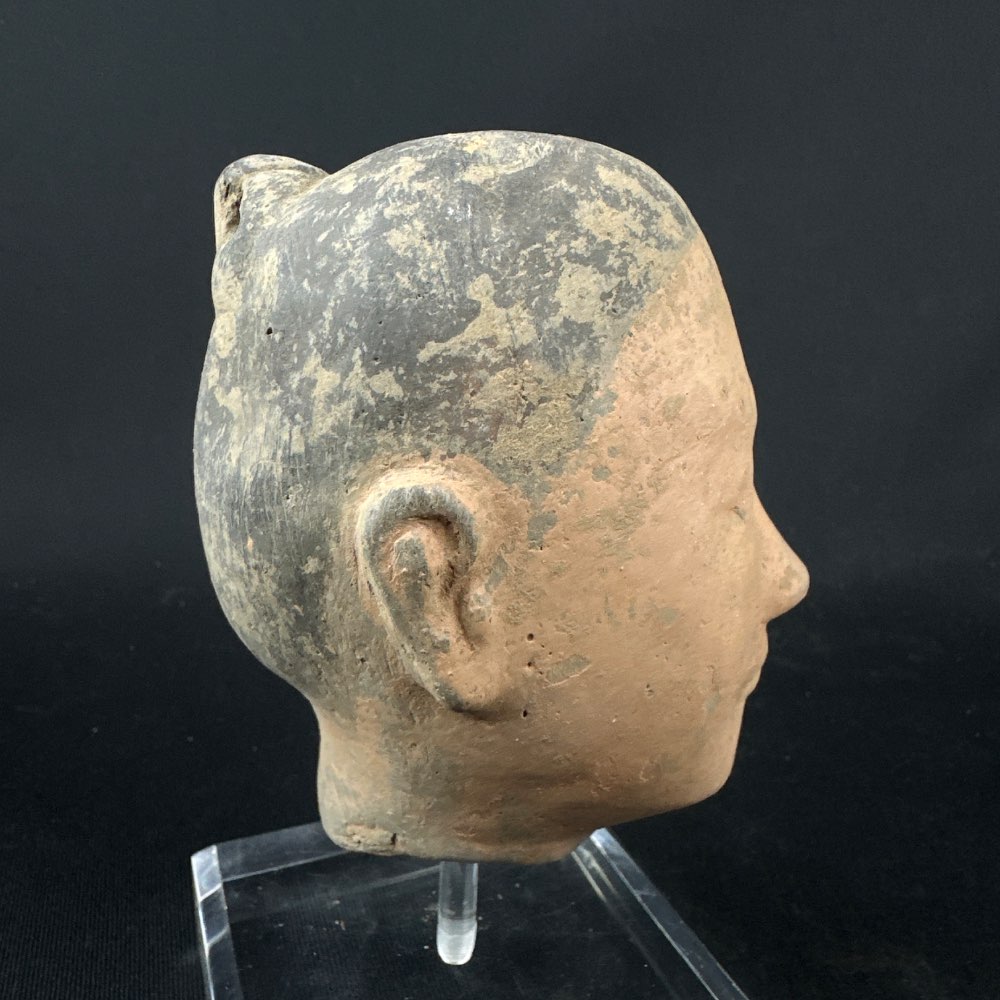


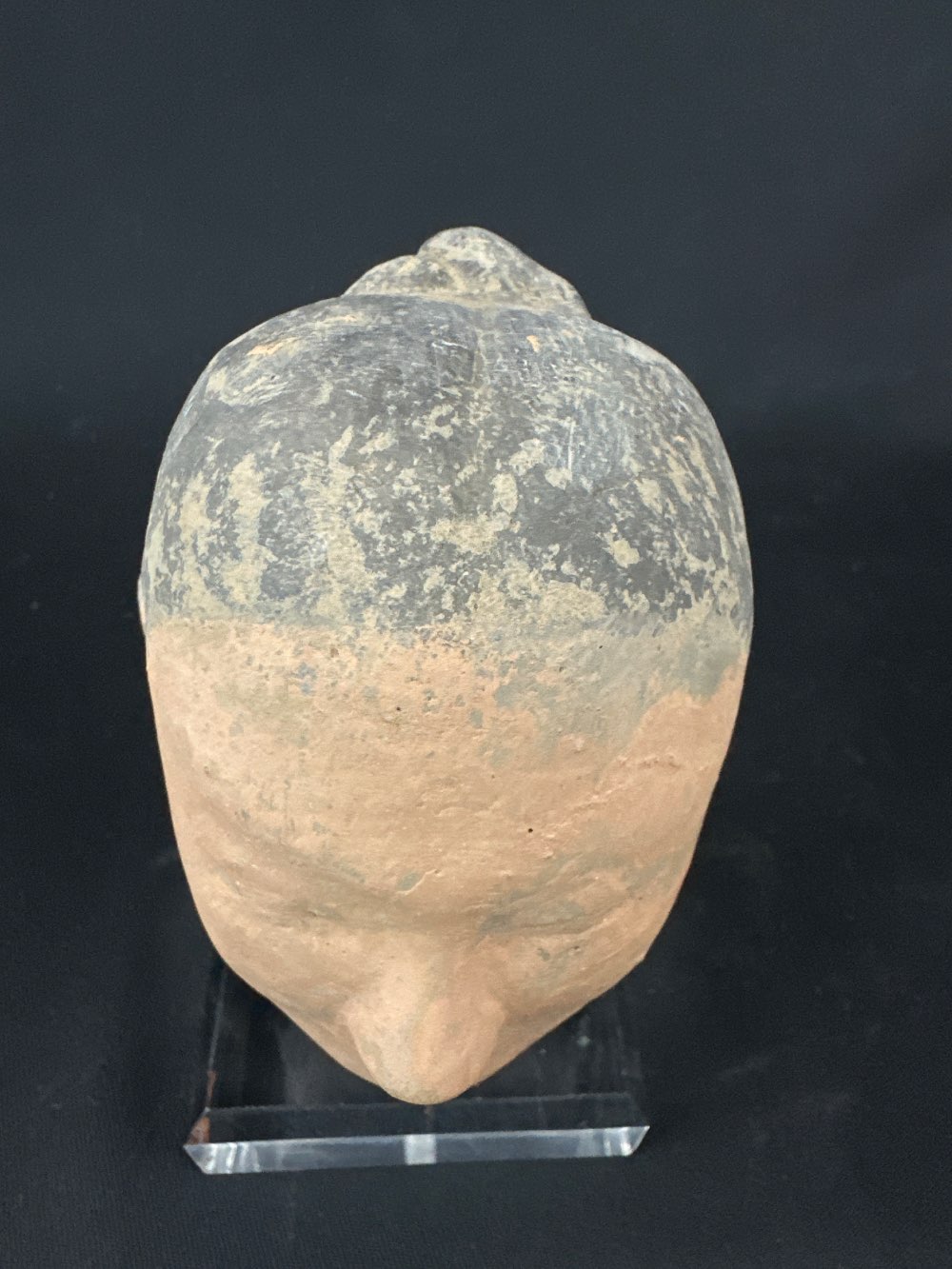
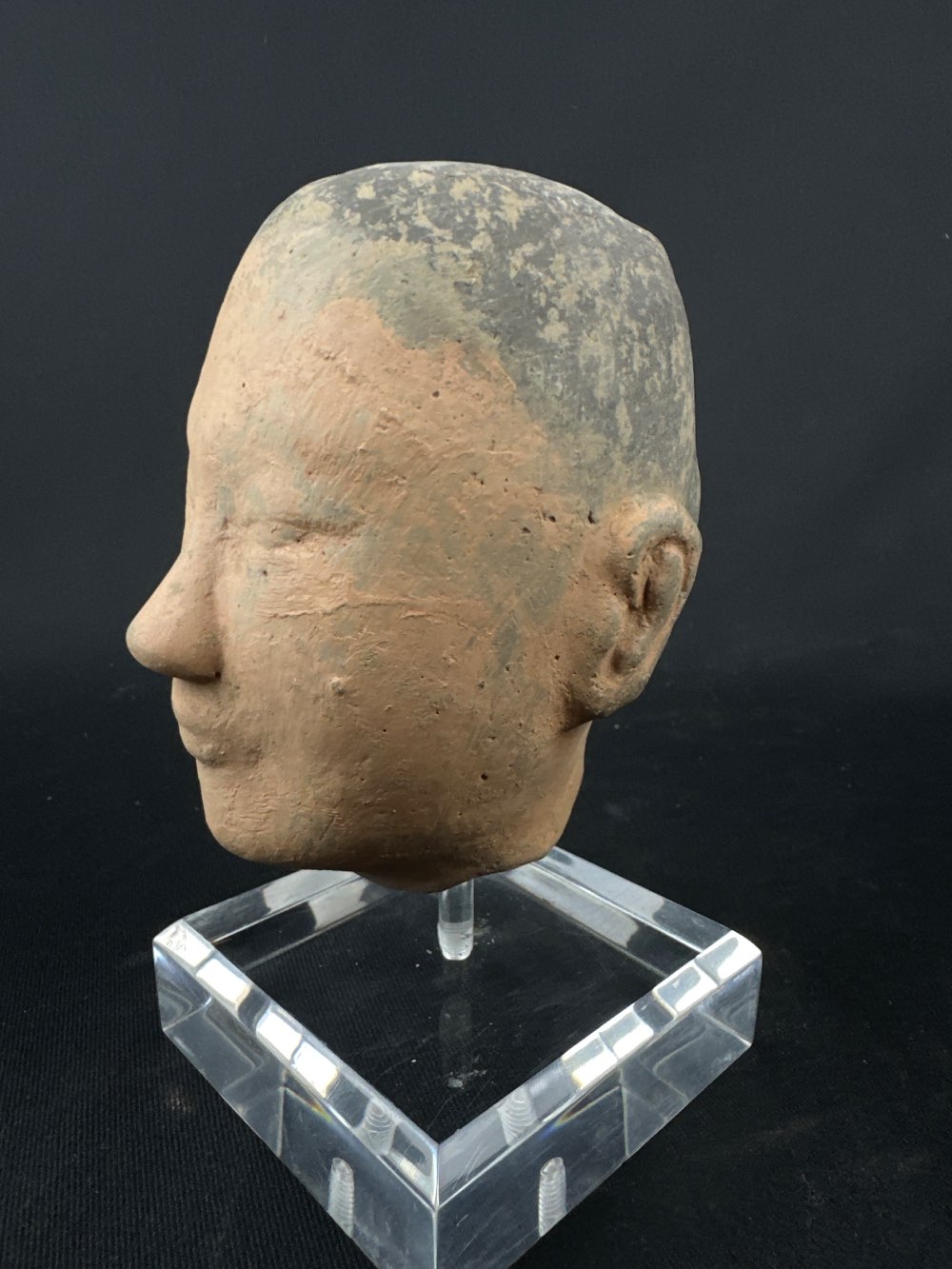
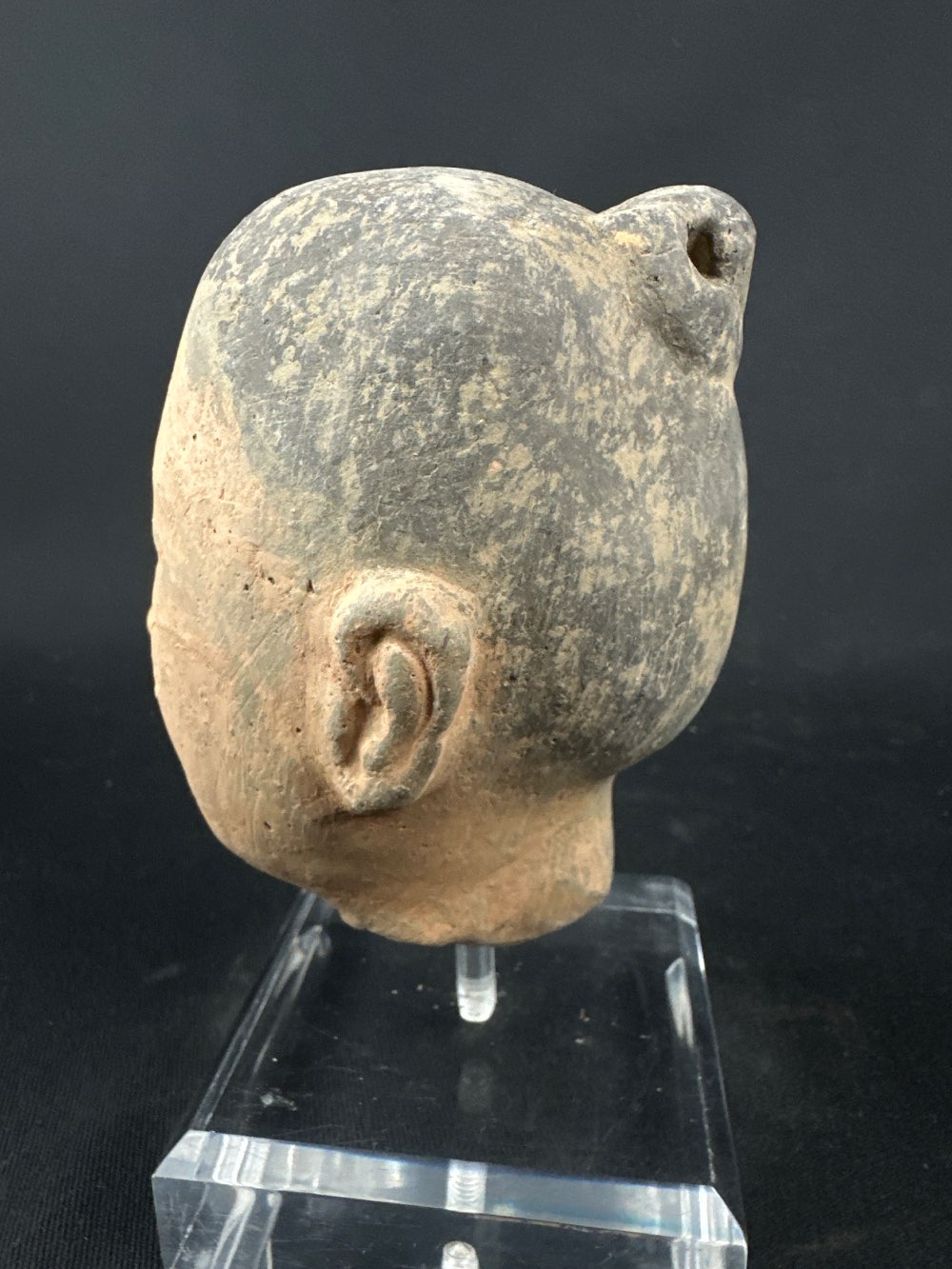

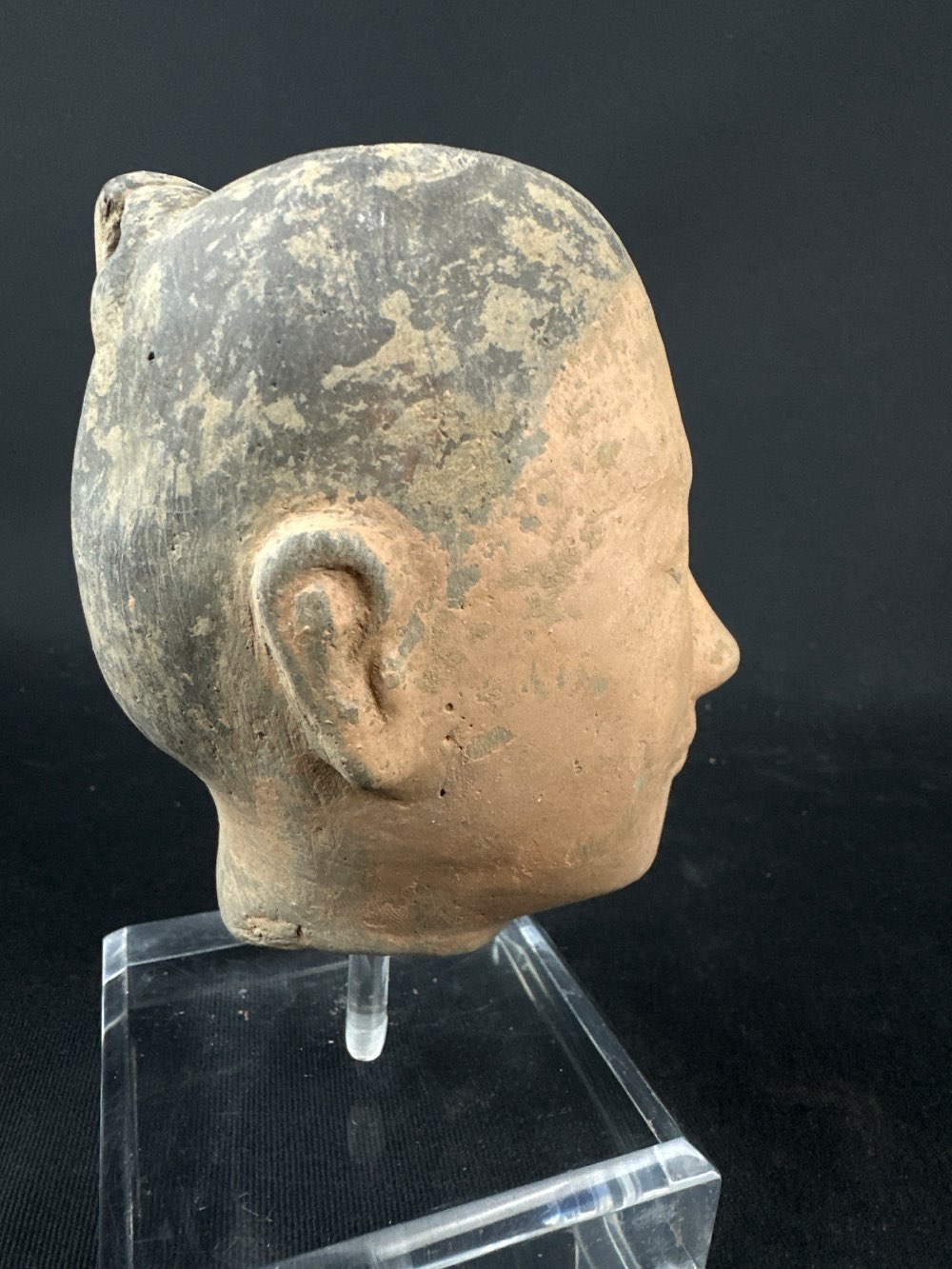



Pottery stick figure head from the han dynasty (206 BC-220 AD)
Pottery stick figure head from the han dynasty (206 BC-220 AD)
- Country: China
- Period: Han Dynasty (206 BC-220 AD)
- Province: Shaanxi
- Material: Terracotta with red, brown and black pigments
- Size: 10 x 8 cm (15 cm incl. stand)
- Comes out of an old Spanish collection.
The stick figures from Xi'an, China, unearthed from the tombs of the Han Dynasty, are fascinating artifacts that provide valuable insights into the cultural and artistic expressions of the period. These figures, often made of wood or clay, are notable for their minimalist and abstract form, characterized by their elongated bodies and simplified features. Despite their rudimentary appearance, they are believed to represent a variety of subjects, including servants, musicians, and dancers, reflecting the daily life and social structure of the Han Dynasty.
These stick figures were typically placed in tombs as burial goods, intended to serve the deceased in the afterlife. This practice was rooted in the ancient Chinese belief in the afterlife, where the dead were thought to require the same comforts and services as the living. The inclusion of such figures was meant to ensure the continued well-being and status of the deceased in the next world.
The simplicity of the stick figures contrasts with other, more elaborate burial items from the same period, such as jade suits or intricate pottery. However, their minimalist design does not detract from their cultural significance. Instead, it highlights a unique aspect of Han funerary art, where the focus was on the symbolic representation of essential services and companionship rather than detailed realism.
These figures also provide a glimpse into the social and economic conditions of the time. The presence of servant figures indicates a hierarchical society with distinct class divisions, where the elite could afford to be accompanied by representations of their household in death. Musicians and dancers among the figures suggest the importance of entertainment and cultural activities in Han society.
Archaeological discoveries of these stick figures have also shed light on the burial practices and rituals of the Han Dynasty. The placement and arrangement of the figures within the tombs often followed specific patterns, possibly reflecting the status of the deceased or the intended role of the figures in the afterlife. These findings have contributed to a broader understanding of Han Dynasty cosmology and the period's attitudes toward death and the afterlife.
Overall, the stick figures from the tombs of the Han Dynasty in Xi'an are more than mere artistic objects; they are cultural artifacts that encapsulate the beliefs, social structures, and daily life of one of China's most influential historical periods. Their discovery continues to enrich our knowledge of ancient Chinese civilization and its complex, multifaceted approach to life and death.
____________________________________________________
The pottery stick figures from the Han Yangling Tomb and Museum are some of the most striking and enigmatic artifacts from China’s early imperial era. Discovered in the mausoleum of Emperor Jing of Han (r. 157–141 BCE), these clay figures provide a vivid and haunting glimpse into the court life, military, and cosmology of the Han dynasty.
The Han Yangling Mausoleum: Context
- Located near Xi’an, Shaanxi Province, the Han Yangling mausoleum was the burial site of Emperor Liu Qi (Han Jingdi) and his empress.
- Built in the 2nd century BCE, it is part of a larger necropolis with over 80 satellite tombs.
- The site is now preserved as the Han Yangling Museum, featuring in-situ displays of excavated figures under glass walkways.
The Pottery Stick Figures: Features and Form
These stick-like clay figures are immediately recognizable for their:
- Thin, elongated torsos with minimal musculature—hence the term "stick figures"
- Articulated limbs: the arms were made of wood or fabric and attached separately, allowing them to be poseable
- Detailed heads and faces, with serene, individualized expressions
- Figures are generally about 1/3 life-size (around 60–70 cm tall)
They represent a wide range of figures, including:
- Court attendants
- Soldiers and guards
- Musicians and dancers
- Eunuchs, maids, and servants
- Farmers, cooks, and herders
Some were originally clothed in silk robes, now lost, but textile traces remain.
Purpose and Symbolism
These figures were not merely artistic—they served important ritual and symbolic functions:
Substitute for Human Sacrifice
- In earlier Chinese dynasties, real people were sometimes buried alive with rulers.
- The Han dynasty replaced this practice with clay figurines to serve the emperor in the afterlife, reflecting both ethical changes and evolving spiritual beliefs.
Mirroring Imperial Life
- The figures replicate the entire bureaucratic and social structure of the Han court: from charioteers to cooks.
- This shows the Han belief in continuity between life and afterlife—the emperor’s tomb was a cosmic replica of his earthly palace.
Aesthetic and Technical Innovation
- The realism and diversity of the figures reveal high levels of artistry and social observation.
- Some have traces of pigments—evidence that they were once brightly painted.
- Their modular construction (clay torsos, wooden arms) is unique and practical, allowing for variation and movement.
What They Tell Us
- Everyday Life: The range of roles depicted gives scholars an unparalleled look into daily life at the Han court.
- Military Organization: Miniature soldiers with armor, weapons, and chariots illustrate the structure of Han military power.
- Belief Systems: These figures reflect the Han concern with death, immortality, and ancestor worship, blending Confucian order with Daoist cosmology.
The Han Yangling Museum Experience
- The museum features glass-floored corridors, allowing visitors to walk directly above the burial pits.
- Figures remain in situ, providing an immersive experience unlike most other Chinese tomb museums.
- It is considered one of China’s most important archaeological displays, second only to the Terracotta Army in cultural impact.
Summary
The pottery stick figures from the Han Yangling tomb are haunting yet graceful windows into Han dynasty life. Through minimalism and gesture, they convey a universe of social structure, ritual belief, and imperial ambition. Unlike the grand martial might of the Terracotta Warriors, these figures speak in quiet tones of domesticity, continuity, and the humanity of empire.
Please send an e-mail via below form, WhatsApp or call to order or get more information about this object.
We can communicate in English, Deutsch and Nederlands!

 Stick figure of Han Dynasty in terracotta, TL tested
Stick figure of Han Dynasty in terracotta, TL tested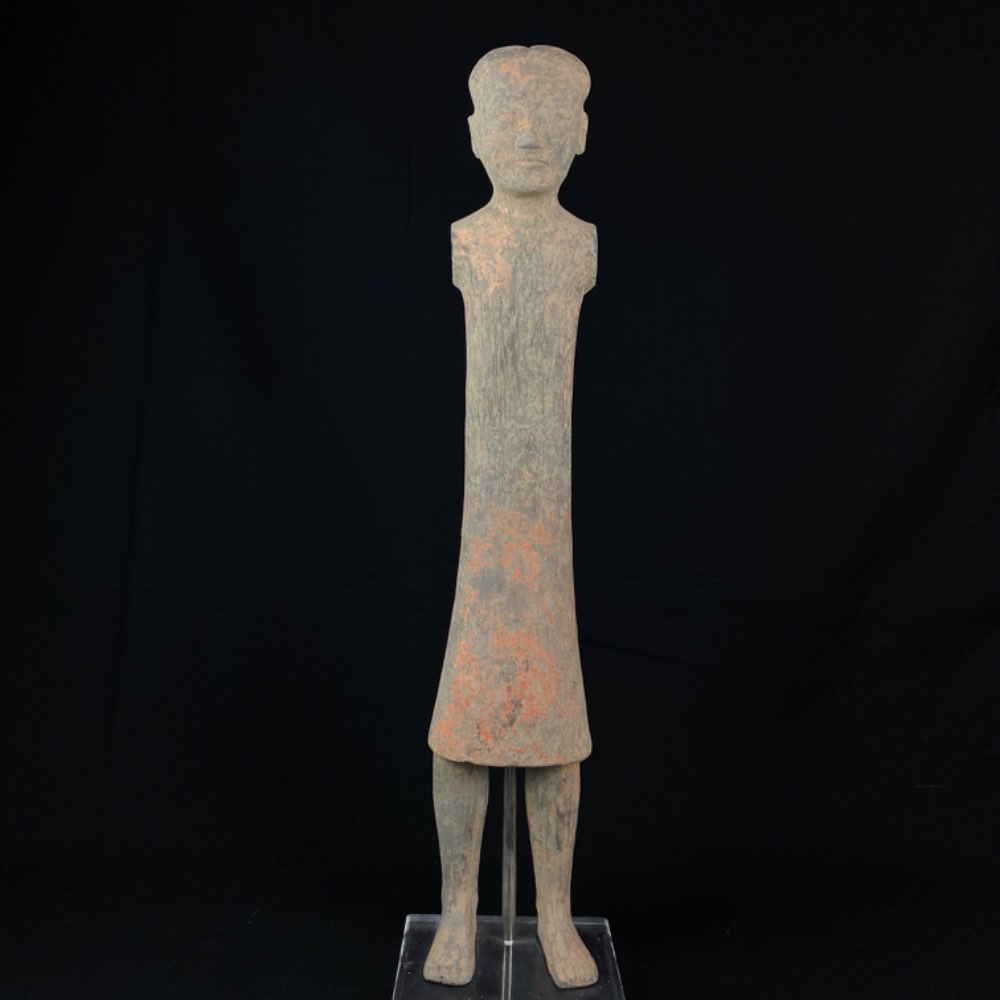 Stick figure of Han Dynasty in terracotta, TL tested
Stick figure of Han Dynasty in terracotta, TL tested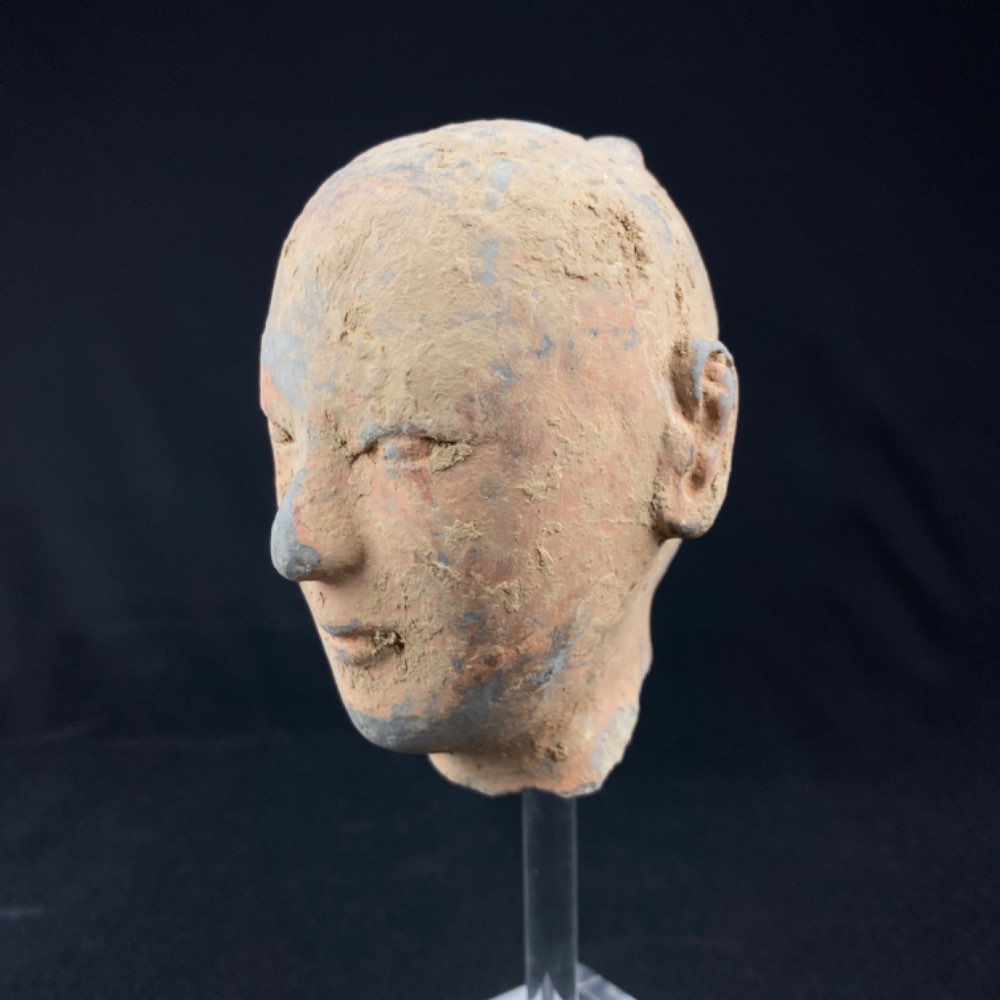 Stickman's head from the Han Dynasty of terracotta
Stickman's head from the Han Dynasty of terracotta Stickman's head from the Han Dynasty of terracotta
Stickman's head from the Han Dynasty of terracotta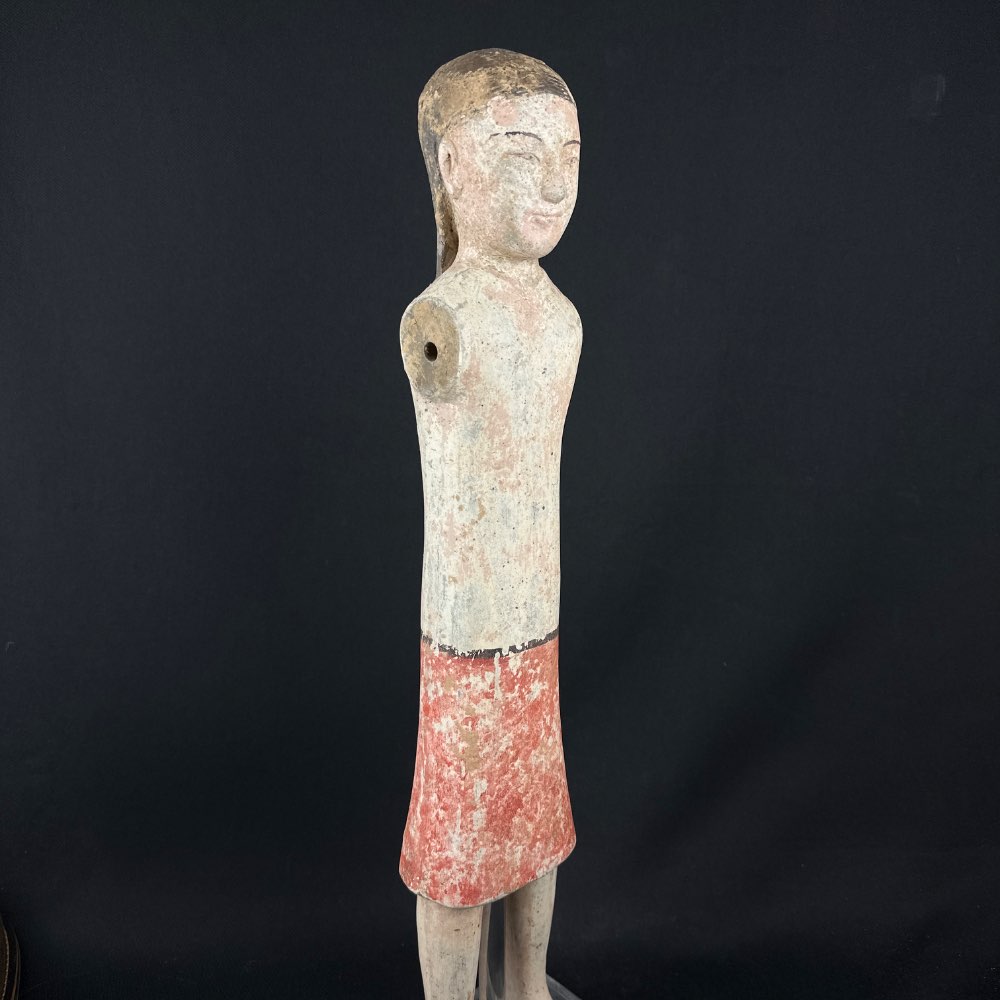 A pottery stick lady from the han dynasty (206 BC-220 AD), TL tested
A pottery stick lady from the han dynasty (206 BC-220 AD), TL tested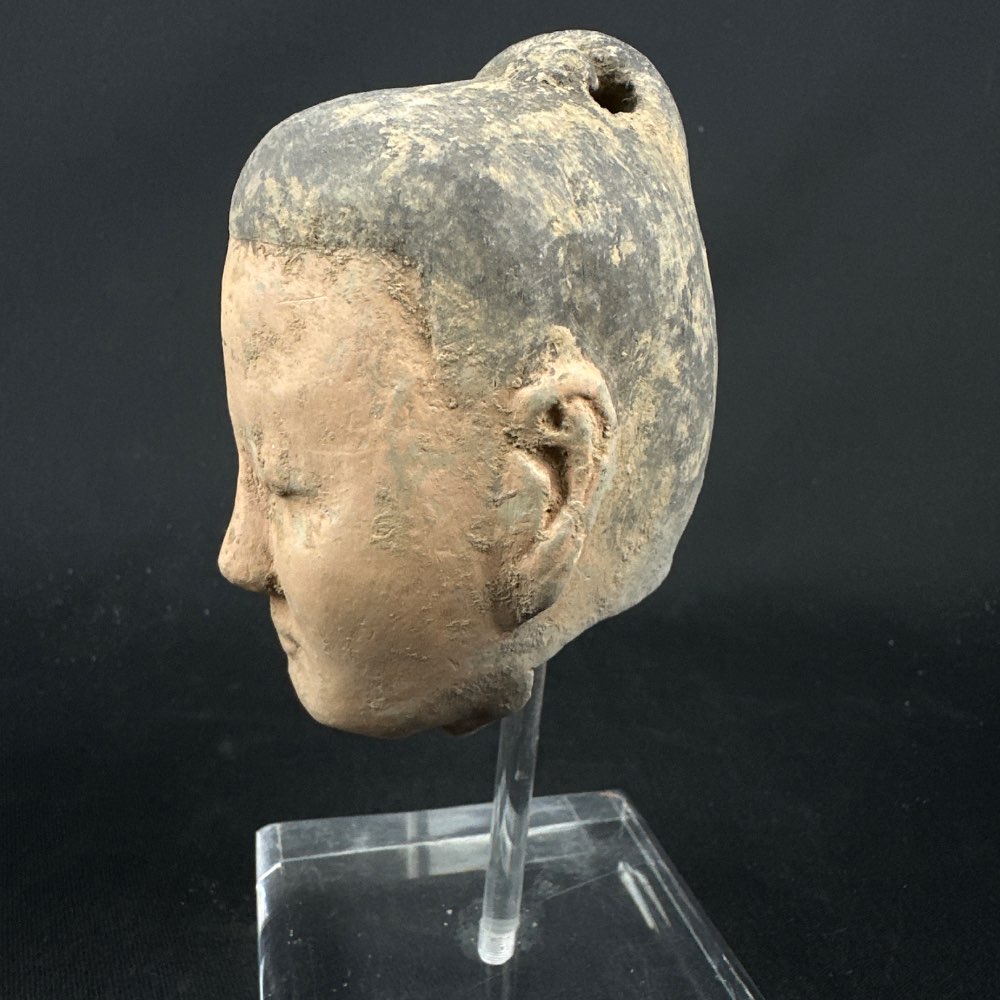 Pottery stick figure head from the han dynasty (206 BC-220 AD)
Pottery stick figure head from the han dynasty (206 BC-220 AD)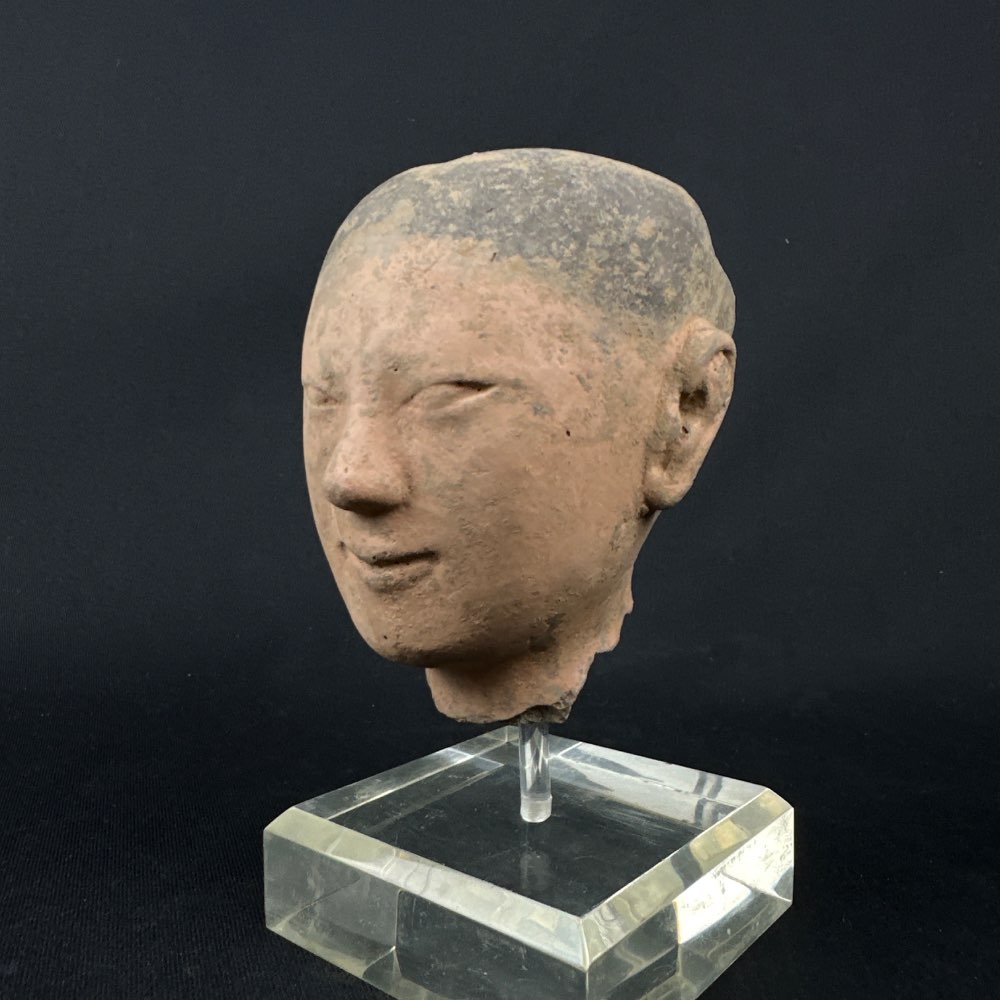 Pottery stick figure head from the han dynasty (206 BC-220 AD)
Pottery stick figure head from the han dynasty (206 BC-220 AD)